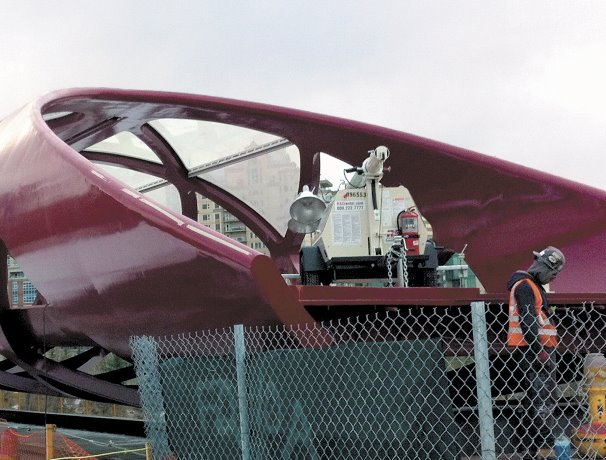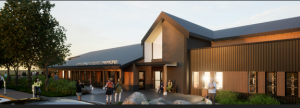Calgary’s Peace Bridge has been open for a couple of years now, but the awards keep rolling in.
The 850-tonne, 428-foot pedestrian and bicycle bridge was designed by Architect Santiago Calatrava and has become iconic in the city.
The latest accolade is the Canadian Architect’s 2014 award for best steel design in the bridges category, which recognizes the innovative blend of glass and steel used in the pedestrian bridge over the Bow River.
The bridge has been described as visually stunning and has already become an icon in the city for both residents and visitors alike.
At 26 feet wide and 19.2 feet of deck, its tubular shape includes curved glass and red steel filigree lattice criss-crossing the length.
The modern structure was intended to be in step with Calgary’s city vibe.
Designed by Zurich-based Spanish-born architect, Santiago Calatrava, the bridge is a departure from his other themes as necessitated by the unusual location, notes Calatrava engineer, Iain Rowe.
Calatrava’s work is also on show at the Allen Lambert Galleria in Toronto, better known locally as Brookfield Place and formerly the BCE Place Atrium with six storeys of vaulted steel and glass.
"It’s (Peace Bridge) right by a heliport so there’s a no fly zone there which meant nothing could be erected high so a cable stayed bridge was a no go," Rowe said.
"Also there were concerns about putting piers in the water of the Bow River, both because of the environmental concerns of disturbing the river bed and because of ice flow."
The result was the tubular design (oval in cross section), he said, which might have created engineering challenges but for the fact that Calatrava is also a structural engineer — as well as a sculptor and painter.
"So he jotted down calculations for the engineering as he went along with the design which really helped us," he said.
In Canada Stantec Consulting Ltd. was the engineer of record, but the architectural and structural design was done by Calatrava.
The other challenges for the bridge were in sourcing materials and installation, said Rowe.
"The glass came from China and the steel is high strength and highly complex so not just anyone could bid on it," he said noting that the team effort from Stantec, contractor Graham Infrastructure Ltd. and local fabricator Norfab Mfg. (1993) Inc. was key to the successful completion.
Sections were first fabricated in Spain and shipped over to the site where assembly took place.
"They pulled the sections off the trucks, welded them on site and then shoved them along these rails, like a railway they’d built over the river to put the whole bridge in place in one go," Rowe said in describing the temporary bridge built at the outset in 2010 to provide the staging platform.
Rowe said the laminated glass panels use both tempered and heat strengthened sheets.
They are edged with an aluminum strip which is glued on with structural silicone and then screwed in place by glazier GIG Fassaden of Austria who worked with local firm Wescom Glass and Aluminum.
"The idea was to create a covered bridge because of Calgary’s climate which can change quickly," he said.
In effect, it pays homage to the covered timber bridges of Switzerland, where their offices are located and those of the Canadian Maritimes and New England.
The bridge is also designed for a 100-year flood cycle which was put to the test almost immediately on completion when Calgary was hit by severe flooding in June 2013.
"Everything was flooded downtown, basements and garages and the power was off," said Rowe.
"It was scary for us because of the bridge but then we heard from our sources in Calgary that the bridge was okay and that it was still lit up and had power."

1/2
SANTIAGO CALATRAVA LLC











Recent Comments
comments for this post are closed